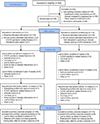Efficacy of a Therapeutic Pelvic Yoga Program Versus a Physical Conditioning Program on Urinary Incontinence in Women : A Randomized Trial
- PMID: 39186785
- PMCID: PMC11473233
- DOI: 10.7326/M23-3051
Efficacy of a Therapeutic Pelvic Yoga Program Versus a Physical Conditioning Program on Urinary Incontinence in Women : A Randomized Trial
Abstract
Background: Pelvic floor yoga has been recommended as a complementary treatment strategy for urinary incontinence (UI) in women, but evidence of its efficacy is lacking.
Objective: To evaluate the effects of a therapeutic pelvic floor yoga program versus a nonspecific physical conditioning program on UI in women.
Design: Randomized trial. (ClinicalTrials.gov: NCT03672461).
Setting: Three study sites in California, United States.
Participants: Ambulatory women aged 45 years or older reporting daily urgency-, stress-, or mixed-type UI.
Intervention: Twelve-week program of twice-weekly group instruction and once-weekly self-directed practice of pelvic floor-specific Hatha yoga techniques (pelvic yoga) versus equivalent-time instruction and practice of general skeletal muscle stretching and strengthening exercises (physical conditioning).
Measurements: Total and type-specific UI frequency assessed by 3-day voiding diaries.
Results: Among the 240 randomly assigned women (age range, 45 to 90 years), mean baseline UI frequency was 3.4 episodes per day (SD, 2.2), including 1.9 urgency-type episodes per day (SD, 1.9) and 1.4 stress-type episodes per day (SD, 1.7). Over a 12-week time period, total UI frequency (primary outcome) decreased by an average of 2.3 episodes per day with pelvic yoga and 1.9 episodes per day with physical conditioning (between-group difference of -0.3 episodes per day [95% CI, -0.7 to 0.0]). Urgency-type UI frequency decreased by 1.2 episodes per day in the pelvic yoga group and 1.0 episode per day in the physical conditioning group (between-group difference of -0.3 episodes per day [CI, -0.5 to 0.0]). Reductions in stress-type UI frequency did not differ between groups (-0.1 episodes per day [CI, -0.3 to 0.3]).
Limitation: No comparison to no treatment or other clinical UI treatments; conversion to videoconference-based intervention instruction during the COVID-19 pandemic.
Conclusion: A 12-week pelvic yoga program was not superior to a general muscle stretching and strengthening program in reducing clinically important UI in midlife and older women with daily UI.
Primary funding source: National Institutes of Health.
Conflict of interest statement
Figures

References
-
- Melville JL, Katon W, Delaney K, Newton K. Urinary incontinence in US women: a population-based study. Arch Intern Med. 2005;165(5):537–42. - PubMed
-
- Thom DH, Haan MN, Van Den Eeden SK. Medically recognized urinary incontinence and risks of hospitalization, nursing home admission and mortality. Age Ageing. 1997;26(5):367–74. - PubMed
-
- Fultz NH, Fisher GG, Jenkins KR. Does urinary incontinence affect middle-aged and older women’s time use and activity patterns? Obstet Gynecol. 2004;104(6):1327–34. - PubMed
-
- Sampselle CM, Harlow SD, Skurnick J, Brubaker L, Bondarenko I. Urinary incontinence predictors and life impact in ethnically diverse perimenopausal women. Obstet Gynecol. 2002;100(6):1230–8. - PubMed
